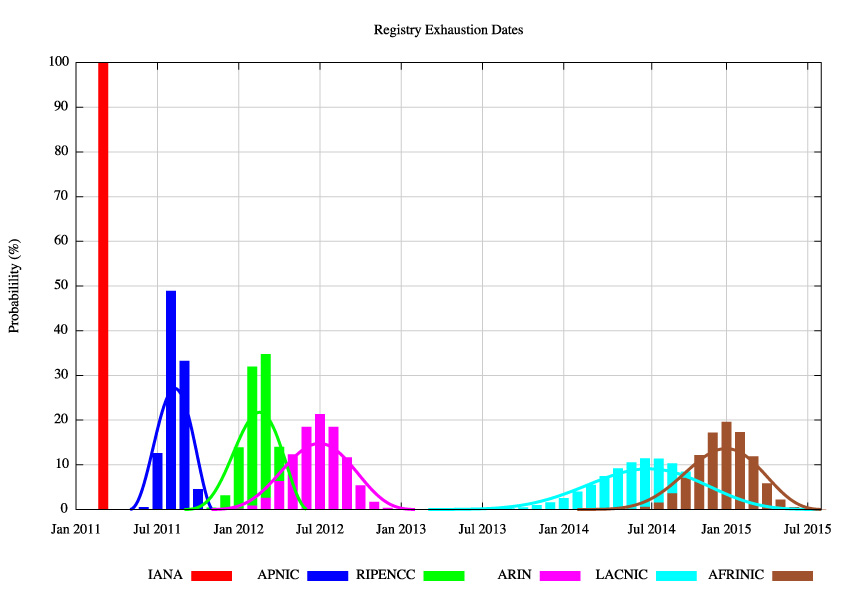What’s the Deal with Internet Addresses?
Last week, the tech press reported that ICANN, the Internet’s central committee for addressing, had assigned the last of the IPv4 addresses. A big ceremony was held in Miami, to much fanfare and very little understanding:
The end of IPv4 (Internet Protocol version 4) addresses was announced in a ceremony in Miami on Thursday morning. Each of the five regional Internet registries (RIRs) was allocated one of the final five large blocks of about 16 million addresses.
The end of the central supply of IPv4 addresses signaled the urgency of enterprises and service providers to migrate to IPv6, the latest version of the protocol, which has been available for more than a decade and allows for an almost unlimited number of addresses. When there are no more IPv4 addresses available from the RIRs, new hosts on the Internet will not be able to communicate with systems that use only IPv4 without special mechanisms that could degrade the Internet experience. Some experts advise adopting a “dual-stack” approach to remain connected with both IPv4 and IPv6 hosts.
“A pool of more than 4 billion Internet addresses has just been emptied this morning,” said Rod Beckstrom, president and CEO of the Internet Corporation for Assigned Names and Numbers (ICANN), which oversees IANA. “The future of the Internet, and the innovation it fosters, lies with IPv6.”
There are at least a couple of problems with this report (typical of the breed, not meant to be singled out for abuse). First, people don’t generally appreciate the fact that people who want IP addresses for their businesses or home computers don’t get them from ICANN: They get them from an ISP, who gets them from a Regional Internet Registry, who gets them from ICANN. So we have a four-level system in which there are actually quite a few free IP addresses floating around the RIRs, ISPs, and organizations that can be traded or reassigned. The RIRs are forecast to run out of IP addresses between August of this year and January of 2015, depending on region; the US doesn’t reach this condition until July, 2012.

Second, not every computer connected to the Internet needs an IP address of the type that’s running out. You can continue to add devices to your home network indefinitely because home networks use private addresses that share a common public address assigned to your so-called home router (actually a “Network Address Translator” or NAT.)
And finally, most of the two billion addresses that have been assigned are not being used: Most inventories report that there are some 600 million computers on the Internet, shared by two billion people, so most of the assigned addresses aren’t being used. As a purely arithmetic exercise, reassignment of the current pool of addresses could keep IPv4 plugging along for quite a while. But that would be short-sighted.
The IETF devised a replacement system for IPV4 called IP Next Generation and then simply IPv6 fifteen years ago, but it’s had a very hard time convincing people to convert from IPv4 to IPv6 despite vigorous efforts. The general problem is that there’s not a smooth upgrade path, so people will have to run both protocols on their computers during a transition period that could take a very long time, like ten years or so. Nobody wants to be first, IPv6 and IPv4 running side by side (the “dual stack” system) consumes memory, and early implementations of IPv6 tend to be buggy.
IPv6 is also much too conservative on the technical side to warrant the expense of early conversion. It really is nothing more than IPv4 with larger addresses, so it fails to address any of the issues that have arisen since the deployment of IPv4 as a lab experiment 33 years ago, such as routing scalability, multi-homing, security, or mobility. There’s very little reason to believe that a better solution will arrive, however, so we’re stuck with late conversion to IPv6 as the only plausible long-term solution to address exhaustion.
A late conversion is better than an early one, as it enables the problems that IPv6 will cause for the Internet’s routing system to be addressed by newer technology in edge routers. The IPv6 foot-draggers are taking the responsible course of action.




[…] This post was mentioned on Twitter by b0rn2frag, High Tech Forum. High Tech Forum said: Richard Bennett on ICANN assigning last Internet addresses "to much fanfare and very little understanding" http://shar.es/3sniE #Internet […]
Every IT manager and CIO and consultant has told me they don’t care about IPv6. They have their block of addresses like every other major player and everything will keep working as is. All the new businesses that need IPv4 addresses will have to lease them at a higher price. Nothing in the IPv4 space will stop working and all the IPv6 adopters will have to be backward compatible with IPv4. The choice is to run only IPv4 or run both IPv4/IPv6 dual-stack. Given that choice, businesses will choose the former every time.
All this talk of IPv6 being a “board level” problem is inconsistent with everything I hear from businesses.
Here’s the humorous ‘The Office’ video on IPv6 that has reached an astounding 50K views by now:
http://www.youtube.com/watch?v=eYffYT2y-Iw&NR=1
Ipv6 is an inevitable fact that is predestined to come true. Those who do not adapt and change to new technologies are doomed to failure.